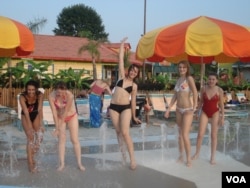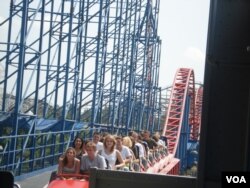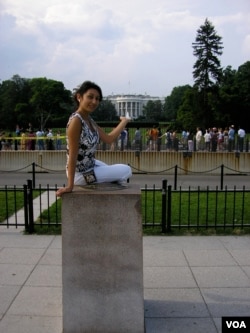While I was watching American shows and movies on Romanian television, the décor around me became surprisingly similar to that on the screen. The small colored houses, with ducks and chicken raised in the backyards, were replaced by large, beige homes with perfectly cut grass, bird feeders and playful pets. The gray, block, low-rise buildings became taller, and the more I looked at them, the more they seemed like modern glass skyscrapers. Was I dreaming? When and how did this transformation happen?
The change began with the first waves of democracy and modernity in Romania after the 1989 Revolution. To my delight as a child, long Communist speeches were replaced by exciting Western shows, movies and cartoons.
Democracy brought freshness, self-expression, enthusiasm for exploration and unknown possibilities. Just starting school, I was strongly influenced by the country’s newly liberated and celebratory spirit.
The song “Lambada,” recently sampled by Jennifer Lopez, became popular in the 1990s (although I later found out that most Americans haven’t heard of it). The music video exposed Romania’s predominantly white society to images of people of different color and ethnicity dancing together.
In Romania, I had always stood out because I have a darker skin tone than the average Romanian, so this “multicultural” picture was meaningful to me. “Lambada” also created a new fashion of short skirts and colorful, tight tops.
As a teen, I was familiar with Dallas, Beverly Hills 90210, and the Saved by the Bell. On those shows, young people drove cars (sometimes convertibles!) and had their own locker at school. They surfed, swam in the pool and traveled.
Common scenes that began to define my image of America included Chinese food in paper bags, wealthy business men, perfectly organized and color-coordinated weddings, and the unforgettable motif of holding up the whole ceremony to look for the lost wedding rings.
This world was brought to life five years ago, in 2006, when I visited the United States for the first time. When a salesman in a fish market asked me “How are you doing, sweetie?” I was thrilled and amazed. It felt as if he had just emerged from the TV screen and spoke to me, or I had just crawled into the TV and met him.
That was the beginning of a beautiful journey to oceans on the East and West coasts, the view of the Appalachian Mountains, and the bustle and liveliness of big cities, as well as small farming villages and Amish communities where life is simpler.
I had my first summer job in the U.S. working at a country club. I attended a wedding, where the best man lost the rings, just like in the movies. I lived in a big house, where I could find the newspaper every morning at my front door.
I ate delicious crab cakes and other seafood. I even bought my own Chinese takeout in paper bags. I went to classical music concerts and receptions, wearing my first little black dress. I jumped into a swimming pool for the first time and enjoyed a roller coaster ride. I stargazed from a convertible while enjoying jazz.
These experiences gave me a sense of belonging, freedom and empowerment. I lived my ‘American Dream” before I knew that’s what it was called.
The “American Dream” is disseminated through shows and movies that are popular in Romania and worldwide. They create the first impressions for people abroad, setting expectations of what one can find when traveling in America.
My American friends would say “My life is not the same as the movies!” Of course, plots are dramatized and present ideal situations (that’s why it is something to dream about), with more intrigue and challenges than real life. Still, in movies there are certain symbols of American culture like the newspaper on the front porch of the house and “Honey, I’m home” that shape the mentality of people around the world.
At the same time, if American and international students often grow up watching the same American shows, how culturally different are we? If students from different countries are influenced by the same media, are we really different or do we have more in common than we believe?
In a world where culture is imported and exported in real time, we are defined by our ethnicity and local culture only to a certain extent.
Television and the media provide new possibilities of how to live life. Imagination can be more important than knowledge when one is not satisfied with their own culture or political system. One can be in a restrictive environment and still have access to democratic, liberal values which can shape one’s representations of an open and inclusive society.
For many Romanian youth, the influx of Western culture and democratic ideals has enabled us to overcome the consequences of communism and facilitate the process of joining an increasingly global society, with cultural differences but with the common ideals of freedom and development.
Democratic values and multiculturalism that were sown in my youth found a way to bloom when the world of movies transformed my own daily reality. Within the myriad of cultures and peoples of the US, my skin color fits perfectly.
Throughout all the wonder and beauty of this new scene, playing my “American role,” I also found my way to school, and three years later I had my own locker as a student at Vanderbilt University.
The change began with the first waves of democracy and modernity in Romania after the 1989 Revolution. To my delight as a child, long Communist speeches were replaced by exciting Western shows, movies and cartoons.
Democracy brought freshness, self-expression, enthusiasm for exploration and unknown possibilities. Just starting school, I was strongly influenced by the country’s newly liberated and celebratory spirit.
The song “Lambada,” recently sampled by Jennifer Lopez, became popular in the 1990s (although I later found out that most Americans haven’t heard of it). The music video exposed Romania’s predominantly white society to images of people of different color and ethnicity dancing together.
In Romania, I had always stood out because I have a darker skin tone than the average Romanian, so this “multicultural” picture was meaningful to me. “Lambada” also created a new fashion of short skirts and colorful, tight tops.
As a teen, I was familiar with Dallas, Beverly Hills 90210, and the Saved by the Bell. On those shows, young people drove cars (sometimes convertibles!) and had their own locker at school. They surfed, swam in the pool and traveled.
Common scenes that began to define my image of America included Chinese food in paper bags, wealthy business men, perfectly organized and color-coordinated weddings, and the unforgettable motif of holding up the whole ceremony to look for the lost wedding rings.
This world was brought to life five years ago, in 2006, when I visited the United States for the first time. When a salesman in a fish market asked me “How are you doing, sweetie?” I was thrilled and amazed. It felt as if he had just emerged from the TV screen and spoke to me, or I had just crawled into the TV and met him.
That was the beginning of a beautiful journey to oceans on the East and West coasts, the view of the Appalachian Mountains, and the bustle and liveliness of big cities, as well as small farming villages and Amish communities where life is simpler.
I had my first summer job in the U.S. working at a country club. I attended a wedding, where the best man lost the rings, just like in the movies. I lived in a big house, where I could find the newspaper every morning at my front door.
I ate delicious crab cakes and other seafood. I even bought my own Chinese takeout in paper bags. I went to classical music concerts and receptions, wearing my first little black dress. I jumped into a swimming pool for the first time and enjoyed a roller coaster ride. I stargazed from a convertible while enjoying jazz.
These experiences gave me a sense of belonging, freedom and empowerment. I lived my ‘American Dream” before I knew that’s what it was called.
The “American Dream” is disseminated through shows and movies that are popular in Romania and worldwide. They create the first impressions for people abroad, setting expectations of what one can find when traveling in America.
My American friends would say “My life is not the same as the movies!” Of course, plots are dramatized and present ideal situations (that’s why it is something to dream about), with more intrigue and challenges than real life. Still, in movies there are certain symbols of American culture like the newspaper on the front porch of the house and “Honey, I’m home” that shape the mentality of people around the world.
At the same time, if American and international students often grow up watching the same American shows, how culturally different are we? If students from different countries are influenced by the same media, are we really different or do we have more in common than we believe?
In a world where culture is imported and exported in real time, we are defined by our ethnicity and local culture only to a certain extent.
Television and the media provide new possibilities of how to live life. Imagination can be more important than knowledge when one is not satisfied with their own culture or political system. One can be in a restrictive environment and still have access to democratic, liberal values which can shape one’s representations of an open and inclusive society.
For many Romanian youth, the influx of Western culture and democratic ideals has enabled us to overcome the consequences of communism and facilitate the process of joining an increasingly global society, with cultural differences but with the common ideals of freedom and development.
Democratic values and multiculturalism that were sown in my youth found a way to bloom when the world of movies transformed my own daily reality. Within the myriad of cultures and peoples of the US, my skin color fits perfectly.
Throughout all the wonder and beauty of this new scene, playing my “American role,” I also found my way to school, and three years later I had my own locker as a student at Vanderbilt University.









